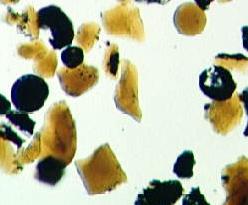|

|
|
Fig. 1 - The orange lunar soil discovered by Apollo
17 astronauts, as seen through a microscope. Some particles
are spherical, indicating they were formed as molten drops
ejected from an impact. Others are irregular, formed by
mechanical fractures. (NASA)
|
|
|
 The soil on the moon
looks like it's wet, or is made of plaster or something. Look at how
sharp the footprints and other impressions are? The soil on the moon
looks like it's wet, or is made of plaster or something. Look at how
sharp the footprints and other impressions are?
Several powdered substances on earth exhibit this behavior.
Anything finely powdered, such as cornstarch or flour, will clump when
packed. Even earth dust, if sufficiently fine, will receive a print
quite well even when dry.
The secret is in the microscopic structure of the individual soil
particles, shown at right. On earth most soil particles rub against
each other as they are acted upon by wind and water. This rubs off
the rough edges. But lunar soil has no wind or water to erode it at
the microscopic level, and so it retains those sharp edges that allow
each particle to "catch" its neighbor and display the remarkable
cohesion we can observe.
 Couldn't earth powders
like Portland cement, which are chemically similar to lunar dust and
very anhydrous, be used to simulate the impressibility of lunar dust
on earth? Couldn't earth powders
like Portland cement, which are chemically similar to lunar dust and
very anhydrous, be used to simulate the impressibility of lunar dust
on earth?
The impressibility of the soil is not hard to duplicate. As noted
above, many powders are impressible. But none of them has the
combination of mechanical, optical, and aerosol properties that we
observe in video and film from the lunar surface. Portland cement,
for example, does not exhibit heiligenschein, or the peculiar halo
effect seen around astronauts' photographs of their own shadow.
Any particulate will aerosolize, which means it will be carried as
random billows appearing to float in the air. Large particles will
not aerosolize as easily, but large particles do not have the
mechanical impressibility as small particles and are unsuitable for
simulating lunar soil. A particulate produced and handled in bulk
will contain particles of nominal size, but also very small
microparticles produced when the larger ones rub together during
handling. Microparticles will aerosolize very easily, even in
relatively thin air. They can be removed by washing, but only for
very small quantities of bulk particulates, and must be used
immediately after washing otherwise further handling will form new
microparticles.
In short, impressibility is easy to simulate. The other
observable properties of lunar soil are very difficult if not
impossible to simulate.
 How could there be soil
without erosive forces like wind and rain? How could there be soil
without erosive forces like wind and rain?
First the conspiracists must make up their minds. They argue that
the dust produced by the lunar module's descent engine would blind the
pilot to the surface below. Then they argue there should be no dust.
Which is it?
In Stanley Kubrick's 2001: A Space Odyssey the lunar
mountains appear sharp and highly detailed. This was the prevailing
opinion of lunar topography when Kubrick's production designers
created their designs. People were surprised to see more rounded
features in photographs returned by the first unmanned probes.
As a matter of fact, wind and water are not the only forces that
cause erosion. The lunar soil is produced chiefly by the
pulverization of the rocky surface by millions of years' worth of
micrometeoroids. And larger ones as well. When a large meteor strikes
the lunar surface, a blanket of pulverized material called "ejecta" is
thrown for miles around the crater.
The moon was also once seismically active. The dark "seas" are in
fact ancient lava flows. Moonquakes dislodge loose boulders, which
tumble down mountains and in turn loosen other portions of the moon's
crust. Rocks grinding against rocks produce gravel and dust -- the
observed regolith.
|
Millions of years of micrometeoroid impacts, geological
activity, and landslides have created the lunar regolith.
|
|
The moon is tidally locked, which is a fancy way of saying that
the same side always faces earth. The process of tidal locking exerts
considerable forces on the lunar surface which can warp and distort
features. A rigid shell over a more elastic core will fracture as the
core changes shape. These fractures, occurring over millions of
years, can reduce the outer shell to small rocks.
Cornell geologist Dr. Tommy Gold maintained the lunar soil would
be several feet thick and that the Apollo astronauts would sink into
it over their heads. Fortunately he was wrong about that, but the
lunar soil is in fact several feet thick. But only the top inch or so
is loose. The rest is very densely packed, and this did not come as a
surprise. But the top scientists at the time knew there would be
particulate matter on the lunar surface, and they knew why.


|








 The soil on the moon
looks like it's wet, or is made of plaster or something. Look at how
sharp the footprints and other impressions are?
The soil on the moon
looks like it's wet, or is made of plaster or something. Look at how
sharp the footprints and other impressions are?
